non-infallible physics
by Omar de Kok-Mercado
This report was written after the residency period 12-26-2020 -to- 1-15-2021. Photos denoted with an asterisk* are by Robb Klassen an L.A.-based photographer and friend of the artist.
After having spent the greater part of three days unfurling bits and pieces of my studio at home, I arrived at Lakeside Lab in the late afternoon of December 26th, 2020. Matt Fairchild welcomed me and we walked the grounds together. It was cold and my truck was packed to the brim with electronic equipment, so I left it running to keep the components from condensing and sweating. As Matt and I walked around Lakeside I felt the energy. Brain power. Even after a year of the COVID-19 pandemic I could still sense the hustle and bustle of Lakeside during the summertime and it was a buzz; I was thrilled to be at Lakeside as its first artist-in-residence during the winter. Marveling at the stone buildings I imagined the tinkling of laboratory glass and the commotion of discovery. I was already looking forward to coming back in the summer. When I finally walked back to the truck I felt inspired and grateful to be at Lakeside and then I unloaded all of my equipment into Mahan Hall wishing I was a painter instead. With all of the fragile equipment warm and safe in Mahan Hall, I suited up and went ice-skating on the lake and looked forward to fostering the magic of creative spirits in the weeks ahead.
I’ve never defined myself as an artist. So, the first few days of the residency I reluctantly surmounted imposter syndrome and embraced my role as artist-in-residence. I’ve always kept my creativity tucked away for professional reasons, citing misalignment with my scientific career. Creation is a reflection of your soul and as a Grade-A-Introvert I have solemnly preferred creating in the relief of isolation and with the tidiness of non-public vulnerability. I enjoy creation for the act and rarely showcasing my work cultivates solitude and it can be empowering. I can maintain companionship with my creations rather than allow them to serve as reflections of me that are subject to outside scrutiny and subsequent judgement. I suppose I agree with mystery and appreciate an opaque-ness to my creative pursuits. Non-infallible physics is the call for behavioral change in the definition of boundaries, scientific or not.
I didn’t arrive at Lakeside with any particular creative vision in mind but I was at Lakeside as an artist and scientist; art and science are both attempts to understand the world around us. The distinction that art and science are fluid is neither profound or original but illuminating for me nevertheless. It’s a good practice to steer away from absolutes and I believe having adaptive perceptions is to be resilient. Throughout my residency I wanted to honor the title of artist-in-residence and lean into it by exploring and, as so many at Lakeside have done before me, I was inspired by the prospect of discovery. Lakeside is a place of experiential learning so everything I did throughout my residency was as such, an experience to learn. It turned out that the theme of experiential learning was the common thread of all the works I generated at Lakeside. This report covers the entirety of my three week residency.
It takes several days to wire together the brain. The brain of this absurd electronic rig that allows me to delve deep into bizarre domains, it’s really a curse and a blessing and perhaps a computational error in my decision-making ability, for better or worse. It’s a love-hate relationship. I told myself I would write down every piece of gear I brought with me but that task leaves a gnarled knot in my stomach and perhaps slightly embarrassed at the quantity of gadgets, tools, instruments, monitors, cables, adapters, power supplies, so on and so forth. The list of gear would be a tome of nerd that would glaze over any determined eye and bludgeon one to boredom so please consider the lack of a list a gesture of compassion. I’ve spent nearly two decades acquiring equipment with a particular vision in mind: to imagine the possibilities and explore the unseen through audio and video. Wiring the brain can be a maddening experience of entanglement and obsession and a process that evolves with every iteration.
After wiring together the brain and other assemblages of the machines I brought with me I set out to explore some video feedback. Diatoms were hard to get out of my headspace as I knew well that Lakeside was renowned for it’s diatom coursework. Although diatom species primarily occur in aquatic habitats there are specific diatom communities that occur in soil that grow alongside other microalgae and cyanobacteria. The algae serve as food for soil protozoa and other organisms such as nematodes and springtails. The soil food web is a true natural wonder and most underestimate it’s ecological complexity. As a soil microbiologist, I think about soil all the time and so it was with my first exploration at Lakeside; I set out to visually create water films on soil aggregates. I designed a video feedback patch and then photographed the projection of the live video feed at different shutter speeds. The results can be observed in the ten plates titled: soil aggregate interactions. It’s fun to imagine these plates being in some exotic explorers travelogue or in some indecipherable alien textbook about biological systems.

soil aggregate interactions plate I

soil aggregate interactions plate II

soil aggregate interactions plate III

soil aggregate interactions plate IV

soil aggregate interactions plate V

soil aggregate interactions plate VI
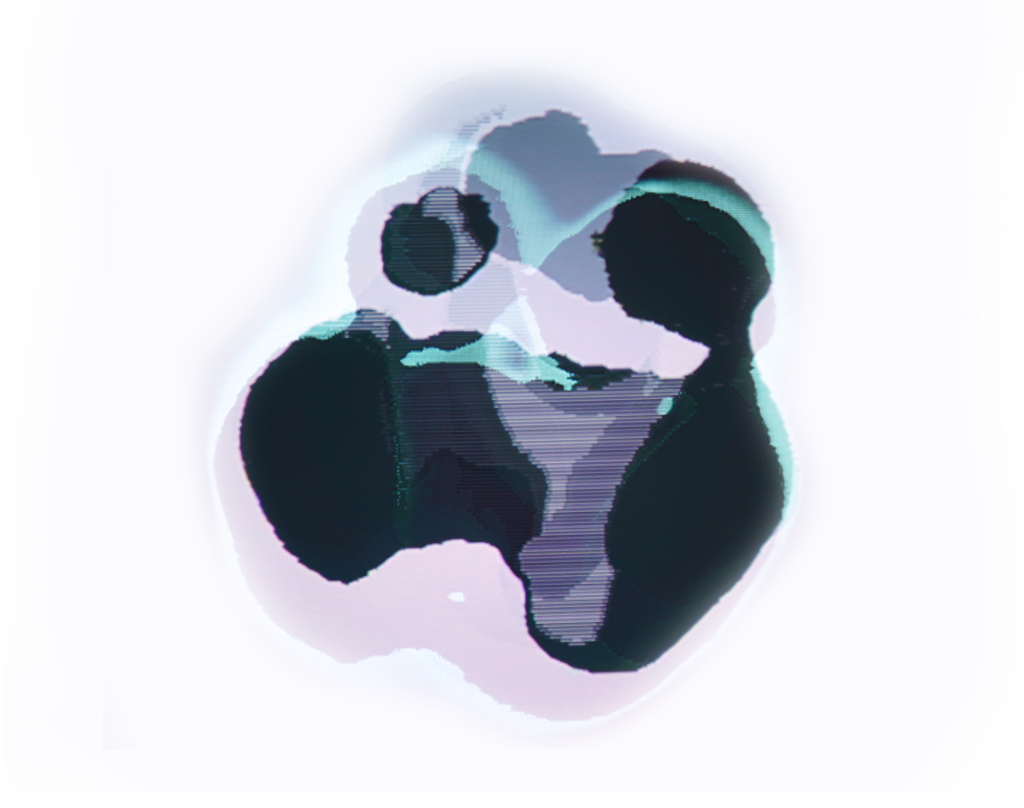
soil aggregate interactions plate VII
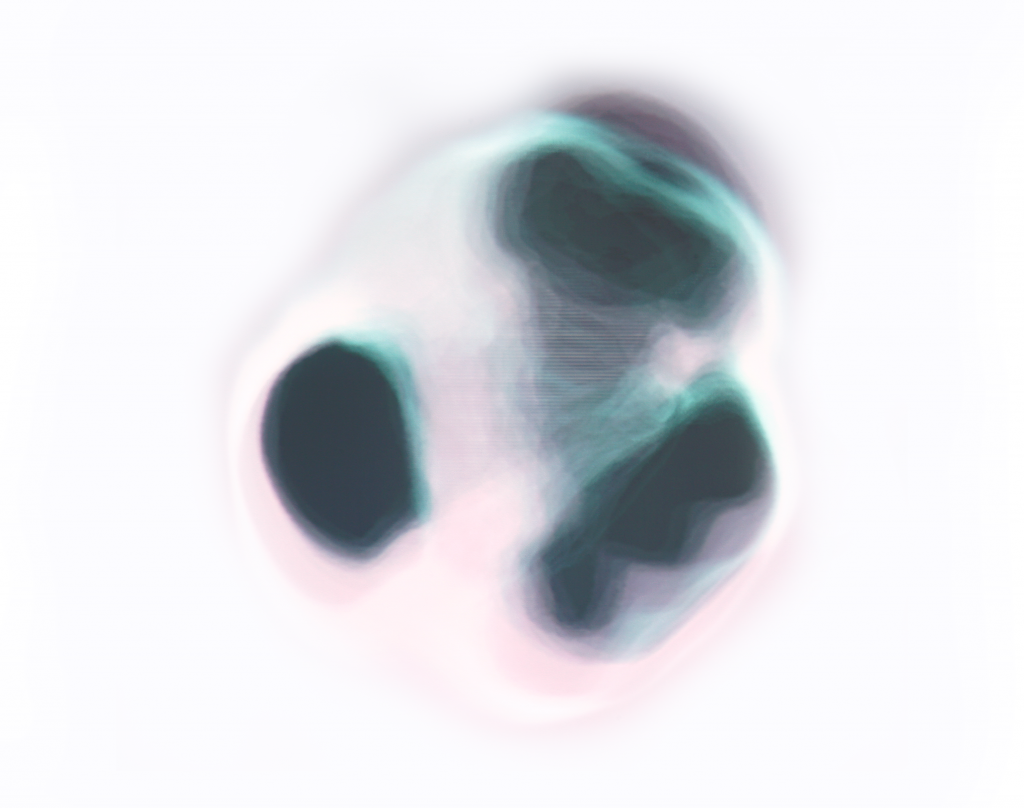
soil aggregate interactions plate VIII

soil aggregate interactions plate IX

soil aggregate interactions plate X
I made this video supplement that describes video feedback and shows the video feed I used to create the ten plates for soil aggregate interactions and the short film celestial beings:
In addition to all of the electronic gear I brought with me I brought a gallon of neon-green paint to experiment with chroma key compositing. Chroma keying is a visual-effects and post-production technique for layering two images or video streams together. The most familiar example of implementing a chroma key is filming actors or objects in front of a blue or green screen. During editing, the blue or green color can be removed and replaced with something else. Post-production chroma key editing is easily done with computers but it can also be done live with real-time rendering video mixers. In general, when you want to remove something via chroma key compositing you want it to be as clean of a removal as possible so it looks realistic. I was curious about the opposite and interested in introducing a bit of chaos, as an organic element, to something that would normally be artificial. So, I had questions I wanted to answer about how different types of objects and Lumia would affect a chroma key.

Neon green paint on plexi glass and cardboard cake boards

Neon green paint on plexi glass. Shot on Little Miller’s Bay

Neon green paint on plexi glass that has been composited with a kaleidoscopic image. Shot on Little Miller’s Bay
The following is an entry from a journal I kept throughout the residency:
12-29-20 Did my first successful chroma key of a painted object. I used cardboard cake (round bottoms) and painted them with neon green 2032-10 (Benjamin moore). I hot glued magnets on the back of them and then affixed them to the projector screen, stood behind it and moved the rounds around each other and titled it celestial beings and put a cheesy 80s style arpeggio back track to it. The bottom video feed was the base video feedback patch I made yesterday and I generated the plates titled soil aggregate interactions. I like this concept. Some things to play around with are the flatness of the object, the depth of the object, the reflectivity of the object or around the object. Paint thickness on translucent surfaces like plexi glass, not fully covering it in paint. I started in on cutting out cardstock stencils of bison in 36 different colors, lots I could do there. Quick thing would be to snap photos on a green background and then manipulate the images in Premiere with scale and positioning. I’d say equipment is fairly fluid and consistent now, the laptop is being used for audio and the desktop is running video, barely. A powerful computer would seal this medium right up, especially with Max/MSP – DC coupled interfaces, eh. The lack of processing power is a welcomed limitation with all of the equipment already in use. I flew the drone over the prairie with a mirror placed in it yesterday. Still need to look at the footage. I might start in on building some kites tomorrow and more chroma key green object painting. Working on a distilled water supply for the fog machine. Snowstorm making it’s way in.
By the 29th I had developed the major concept that I ended up exploring throughout the entirety of the residency: using neon green painted objects and mirror sculptures as metaphors for learning and reflection. Once I started exploring the idea of painting objects neon green and moving them into the natural landscape I found the metaphor for experiential learning to be uncanny. I saw the green circles as gateways to ideas, cultural values, knowledge, perceptions, etc. I found the evolution of this concept reflective of learning itself; as my knowledge grew so did the process. The possibilities for interaction of the paint, mirrors, people, and land are seemingly limitless and even weeks after the residency I’m still scratching the surface of how I can layer this concept into the fold of future projects especially with landscape scale sculptures that can be photographed from hundreds of feet in the air and interactive elements that present themselves with movement of the camera.
As reflection is an integral component of the learning process I was using mirrors as literal reflection sculptures. I was mystified by the vision of a mirror in a natural landscape, it was a magnetic and a comfortable mysticism that spurred this yearning in me for knowing, exploring, and illuminating mysteries. I started hanging mirrors in trees and eventually one made it over to the prairie north of Little Miller’s Bay. When I would overlook Little Miller’s Bay and see the mirror twirling and dancing in the wind from the tree branch it was wonderful. I left some mirrors hanging for days and would revisit them when the weather would change. I hope that the hanging mirrors inspired inquisitiveness of any passerby and perhaps inspired reflection within themselves. I was also thinking of the mirrors as an organic yet artificial addition to the landscape. Similar to the layering concept in chroma key compositing, the mirror being placed randomly on the horizon was almost as if there was a punched out portion of the landscape and the layer underneath was a reflection of itself. Many parallels could be explored with this idea. On December 30th I learned a few things about these plexi glass mirrors:
12-30-20 I had a vision of a full moon illuminating mirrors on a frozen lake and ice skating around them, perhaps holding mirrors myself. Gently gliding like a dancer on a ballroom floor, basking in the moonlight. I went out during the full moon tonight and set up a large mirror but there was too much snow to ice skate and xc skis would not have worked for a gliding effect. Turns out the plexi mirror is not very refractive, and angles were a struggle. Ultimately I think the mirror full moon shot is best reserved for a drone. A mirror must be planted and secured prior to winter so that no footsteps are around it when you want to take a photo or video. I’ll need to apply for my waiver to fly at night. I imagine a sole mirror, like an obelisk/monolith in an open landscape(s) – prairie, snow lakes, woods, etc. I appreciate the vision but it may just be that, to be imagined, rather than realized. Trying to capture it on the lake tonight was humbling, and humorous to think I could do so – I know nothing about night photography! It was rewarding to share that moonlight with the springing sounds coming from underneath the ice, the crunch of the snow, the shining crystals and knowing moon shining on as I stared at it in the mirror. I made the green kite today and got distilled water from Dennis in the limnology lab. Painted the second eye, no hardware work today. Just craftin’, bison (36 colors) are all cut out and ready to be photographed against a green backdrop. Was thinking about dipping whole seed heads into the green paint. Maybe fire up the fog machine tomorrow.

Experimenting with refracting moonlight

Omar experimenting with moonlight on Little Miller’s Bay

Reflection of moonlight on snow on Little Miller’s Bay
On the 30th I also built a kite that was neon-green on the surface. I wanted to fly the kite on Little Miller’s Bay while a drone flying above the kite, tracked the kite. In post-production I wanted to key out the kite and put video of Little Miller’s Bay during the summertime, video of microorganisms and macroinvertebrates from the lake, etc. Again, a metaphor for learning but also a call to thinking about future seasons and the preservation of our natural resources.
1-1-21 Flying the drone, trying to fly a kite, handling plexi glass, trying to keep the equipment free of snow in the blowing wind, sky was completely clear so the snow was gorgeous and bright making it difficult to see the screen of the smart controller. The kite wasn’t strong enough and broke, the string couldn’t be deployed fast enough since it was wrapped around a dowel, so each revolution only released a few centimeters, meanwhile the kite was choking for length slamming itself into the ice on the lake. Oh well, I think I learned a lot, realizing these ideas will take a broader orchestration and coordination of folks helping me out. I ended up having the drone track me while I carried the plexi glass panels that had painted green on them. I want to ski across the lake with a green circle on my head and also take footage of me dragging a panel that’s painted green.
Blessing:
As we look at the stars with our feet grounded beholding wonder
We acknowledge those before us and practice their wisdom
Through the magic of the natural world
As our roots grow deeper we illuminate our souls
With the sunlight that radiates through the trees and flowers
And the grasses that sway with the whispers in the wind
We will nurture the spirit held in the animals that nourish us
We find ourselves
Resilient and adaptive
You are the tree
The sunlight and the darkness
The moon and the ice
The air and the land
From the soil to the stars
You are one Great Spirit.
On January 2nd Meghan and I, after reading our vows, were married by my friend Robb to the blessing I wrote on the 1st. Meg and I are extremely grateful that we were able to have this beautiful experience at Lakeside Lab! We were told by several Lakeside staff that it was a particularly memorable and magical day as the campus was blanketed by a marvelous hoar frost. Matt was also very generous by letting us light an enormous bonfire to celebrate and the conditions were perfect. Thank you Matt and staff! Lakeside will always be special to Meg and I because of this experience. Here I’d like to thank Robb as well, for capturing the day so wonderfully as he so often does with his photography. Thank you Robb!
Meghan and Omar on their wedding day, January 2nd, 2021*
Shimek Hall on January 2nd, 2021*
Prairie grasses and flowers covered in hoar frost on January 2nd, 2021*
1-3-21 Confirmed that the double-sided plexiglass mirror – one side mirror the other side painted neon-green – works well. I want to scale it to large mirror. The flexing is awesome!
Omar walking across Little Miller’s Bay to prototype the first double-sided mirror*
On the third I made the trek out to the lake to prototype the idea of the double-sided mirror, one side mirror and the other side painted neon-green. It worked out really well and I decided to scale it to a four foot mirror that I would end up hanging from tree branches. By the 4th I was scheming all sorts of plans for the green circles and developed a square mask out of a pizza box. I glued magnets on the back of the painted pieces of cardboard and then used other magnets to affix them to my hat or neck gaiter. Simple solutions are the best solutions. Honestly, the process was quite hilarious to watch and I imagined there were plenty of ice fishermen/women/kids that were cracking up at seeing me with a green circle on my face interacting with a drone while Robb, 6’5″ and a formidable force used to balmy California, was freezing and running around framing shots of the process. I ended up spending the next several days exploring the Lakeside grounds with the green mask on and started incorporating mirrors into those shots. I collected over 300gb of data throughout the residency and have yet to process much of it. I’m seeing now that the residency was a time of research and development and I’m looking forward to taking these ideas and exploring them in greater detail. I’ve chosen to leave this report primarily static and as I develop new video works from my residency I will be posting them to my YouTube channel, which I intend to use as a video sketchbook. I’ll also be using Instagram occasionally. I created a brief showcase video that shows many of the elements I developed throughout the residency that you can watch here:
1-4-21 painted one of the large mirrors neon-green on the back last night and cut out a larger square from a Pub19 pizza box and painted that as well – I’m turning it into a mask. I also got a coat on one of the portable black easels and will do second coats on the easel and mirror tonight. The neon-green circles have evolved into “portals” or concept maps/ideas/cultural statements each circle that’s introduced in clip could be isolated with a cropped mask so as to only key out one circle at a time and layer the videos individually. The initial videos that I’m wearing the small circle on my face would be the first stage of observation then I evolve with a larger square head and begin manipulating portals. E.g., several circles are on trees, square man comes through the shot and grabs portals and puts them in his head – experiential learning at lakeside. Next is the larger mirror and walking through the prairie grabbing circles. The square man could also be a metaphor for thinking outside of the box, being open-minded, accepting of alternative views, etc. A double sided mirror hanging from a tree by the lake could have lots of interesting footage on the other side of it, perhaps calling to action water quality awareness with images of conservation in agriculture. This could be expanded to reflect the opposite as well.

Omar painting the back side of a mirror green in Mahan Hall*
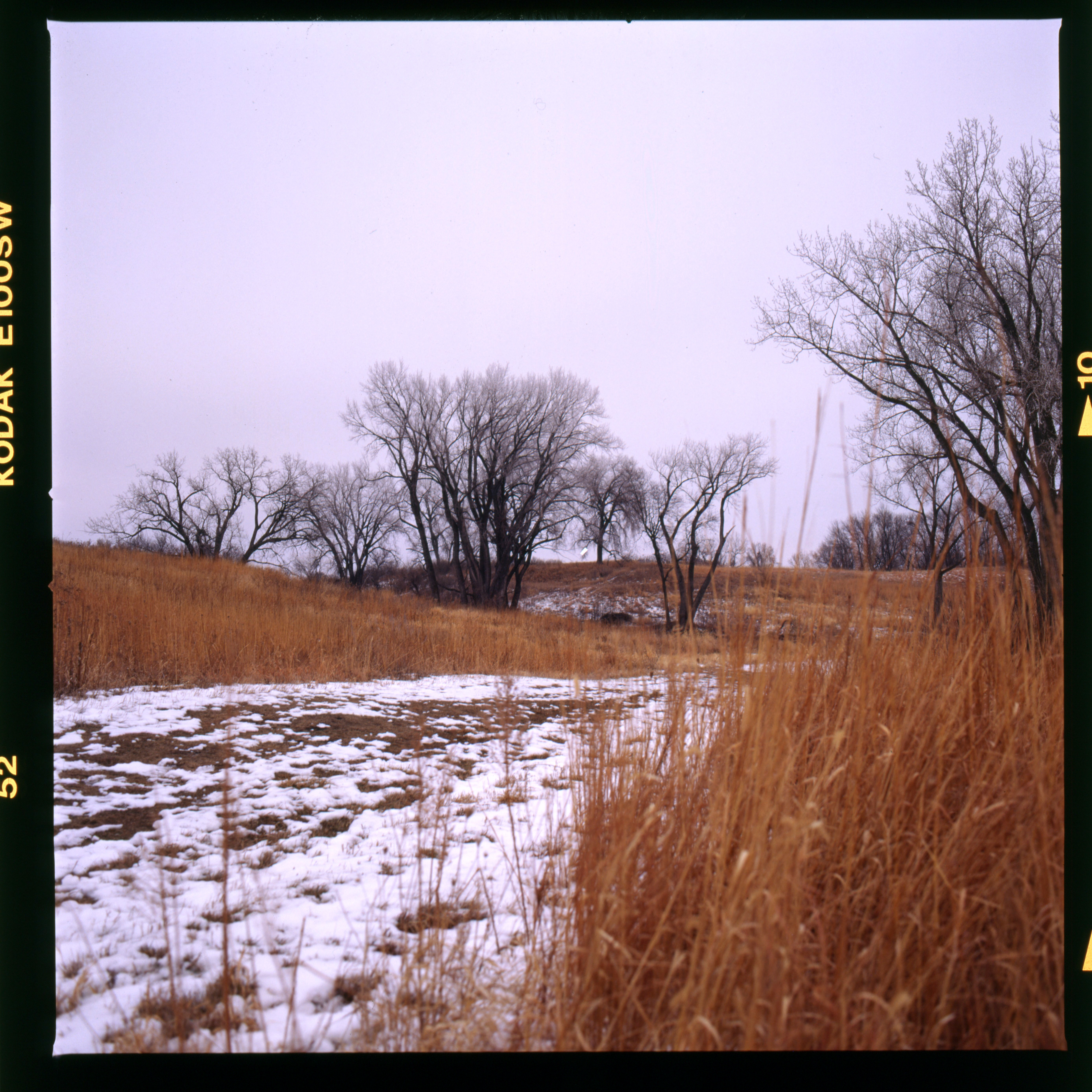
A mirror hangs from a tree in the distance*
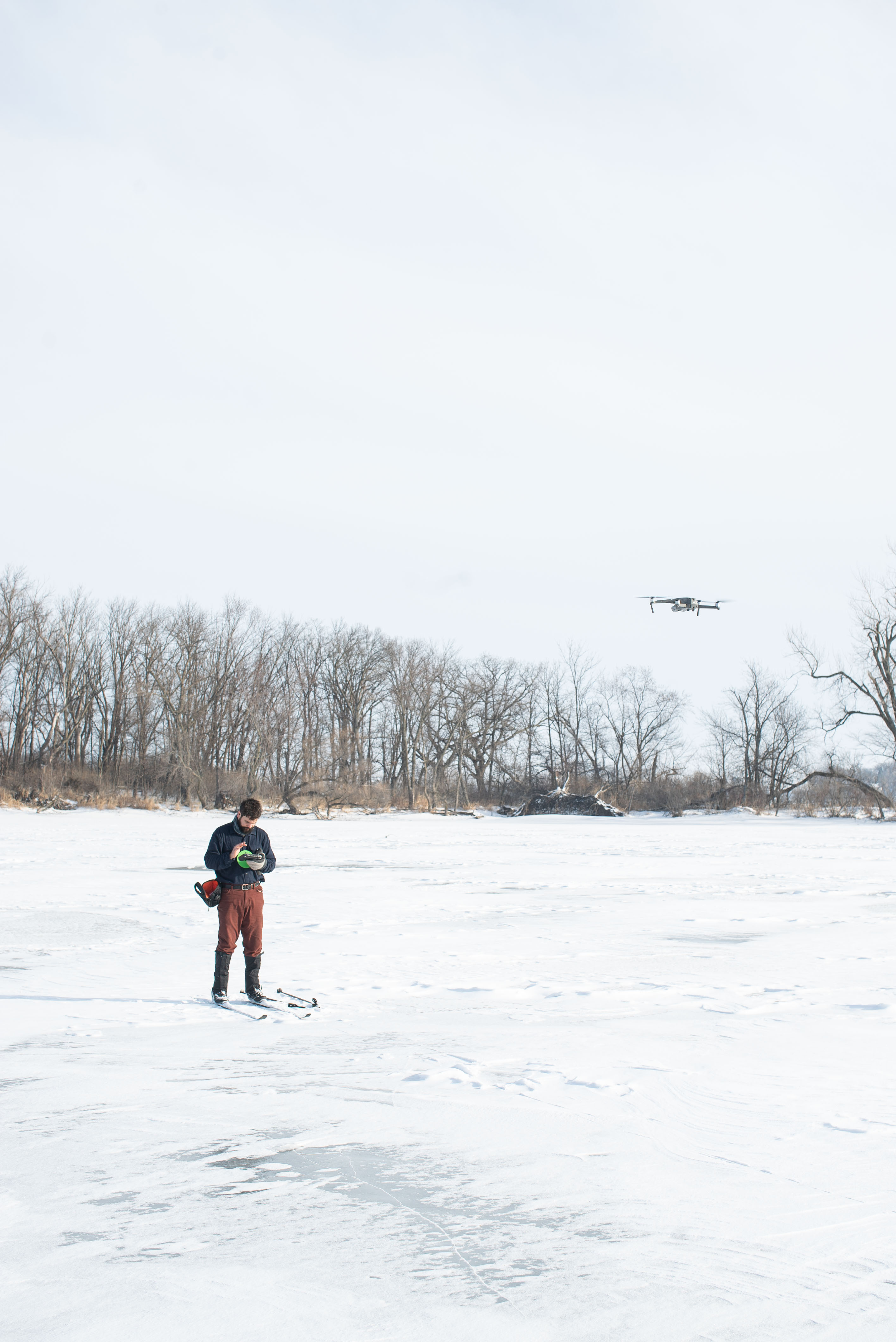
Omar programming the drone to track his face as he skated across Little Miller’s Bay*

The green man stands on Little Miller’s Bay*

Omar cross country skiing on Little Miller’s Bay as the drone tracks his face*

Omar prototyping the green mask with drone tracking on Little Miller’s Bay* If it weren’t for the drone it’d be hard to timestamp this photo
1-5-21 Off to hang the big mirror up where Robb and I scouted yesterday and film with a stabilizer the square face man on skis pulling the mirror behind him. A metaphor for being open-minded, hanging it like a magnet up in the trees to attract energy and ideas as they whisper in the wind. Got another coat on the easel and mirror so will try those ideas out today. Hung up the double-sided mirror and interacted with it with the square man. I think it’s cool but it takes away the mysticism of the floating mirror. Thinking it’d be good to get some footage of square man in the buildings around campus “learning”, looking out at the lake etc.
Omar wearing the square green mask looking out at Little Miller’s Bay* As the chroma key compositing evolved it became a metaphor for learning
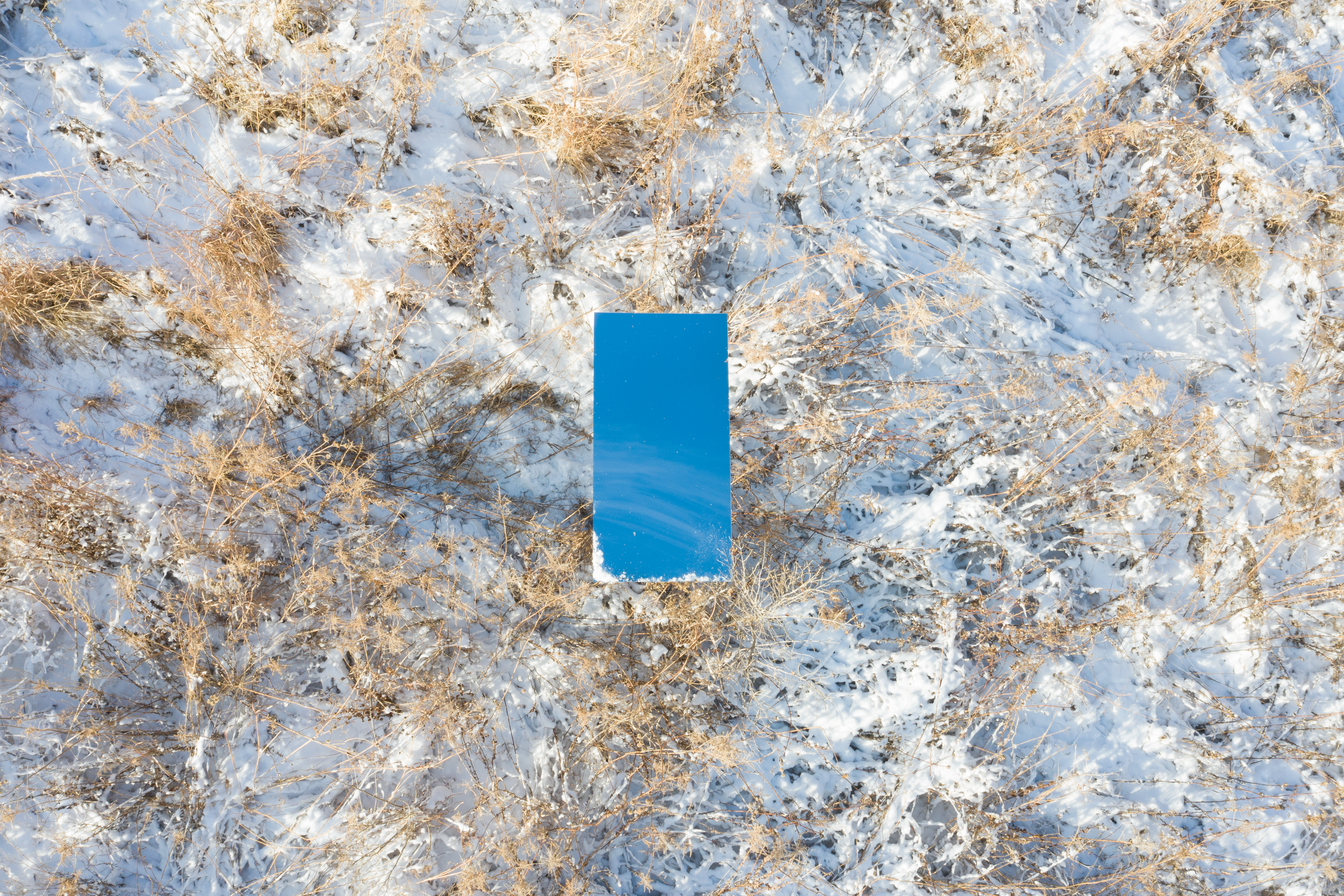
A mirror sits in the prairie by Mahan Hall
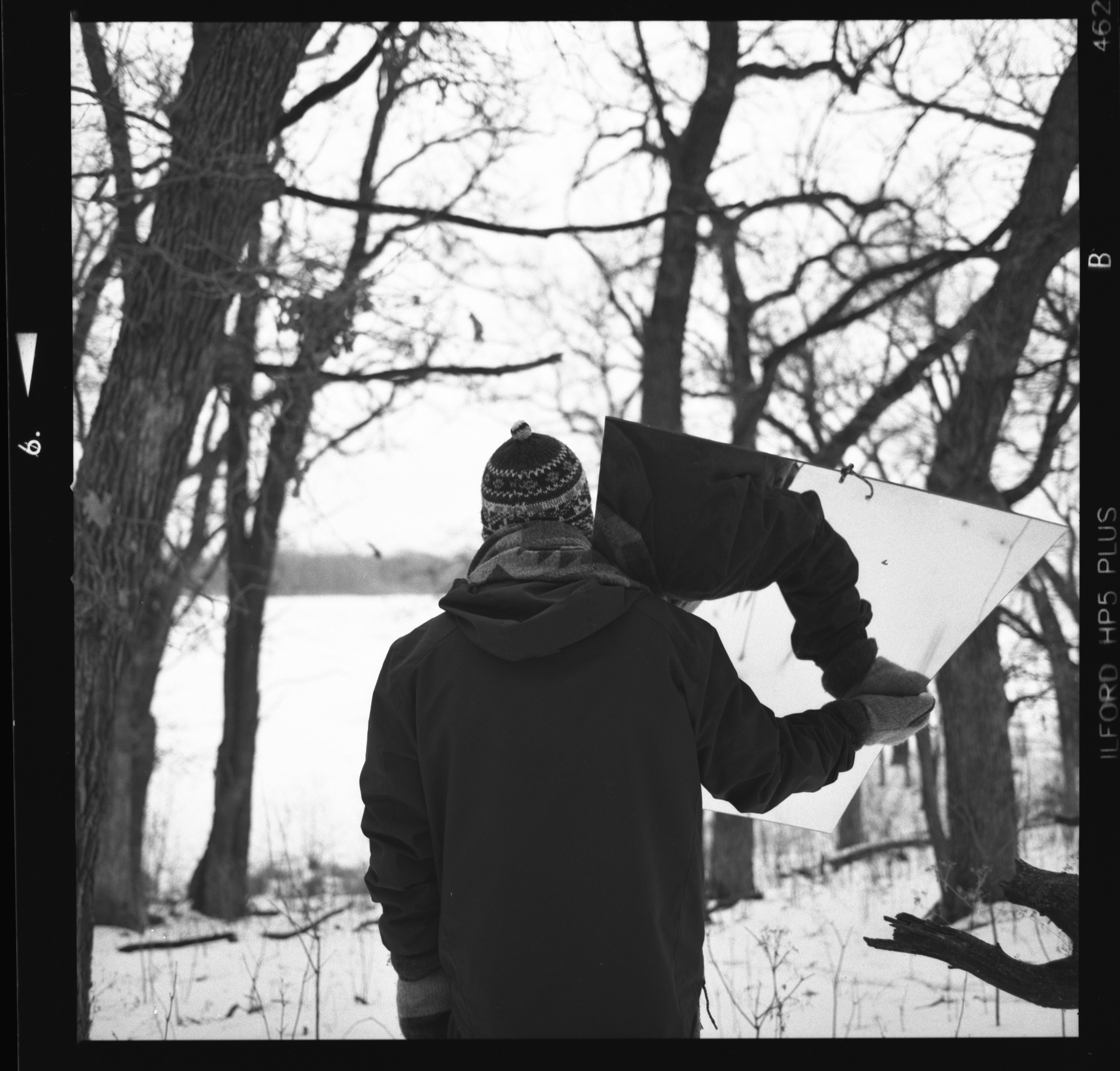
Omar holding a mirror and overlooking Little Miller’s Bay*

Trees overlooking Little Miller’s Bay*

Ice on Little Miller’s Bay*

Snow on Little Miller’s Bay*

Clouds, trails, and ice on Little Miller’s Bay*

Clouds, snow and trapped air on Little Miller’s Bay*

Omar making the trek north across Little Miller’s Bay to hang a double-sided mirror in a tree*
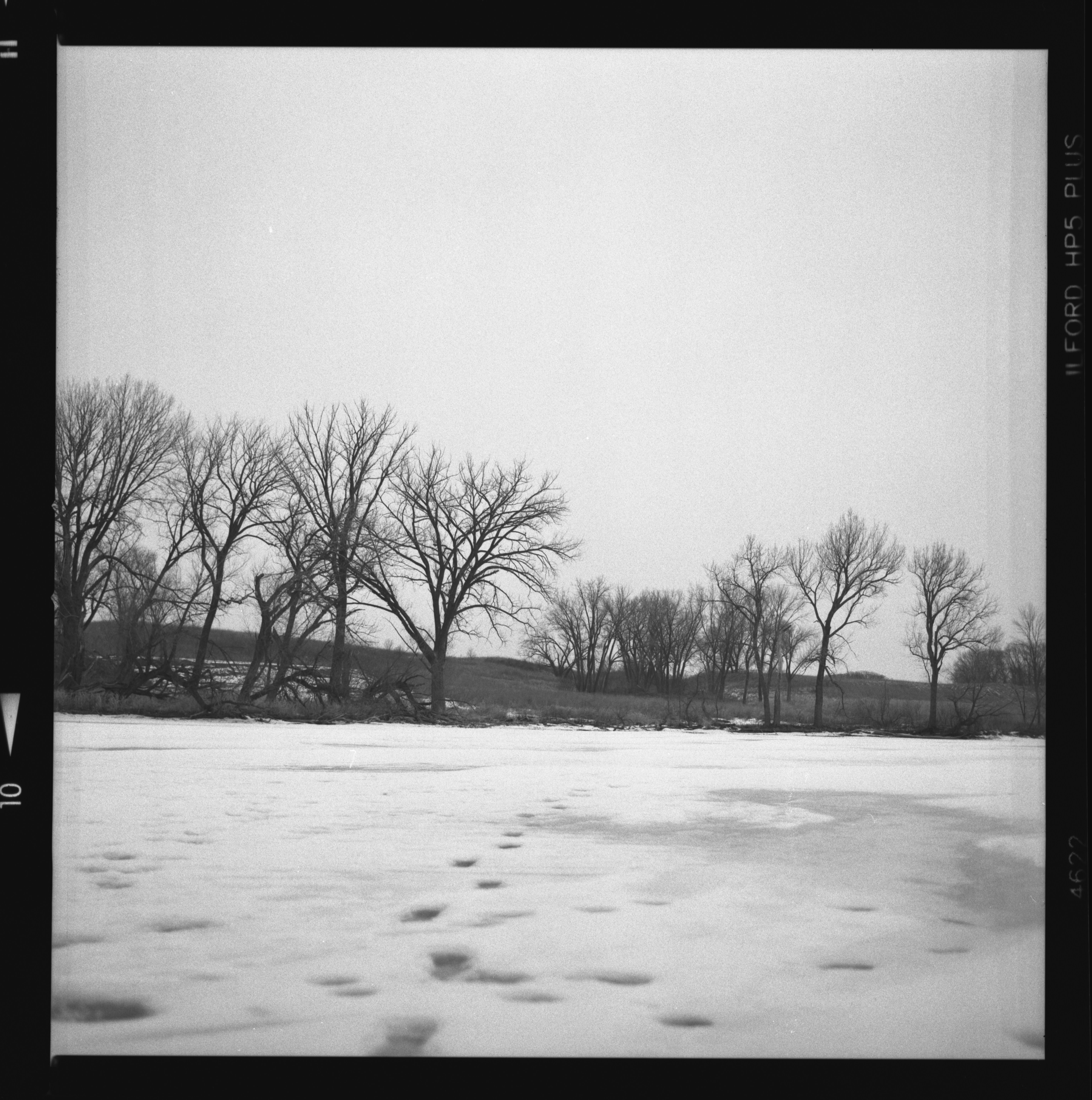
The path north across Little Miller’s Bay to the prairie*

Omar standing with the double-sided mirror in the prairie north of Little Miller’s Bay*

A mirror swings from a tree branch*

Mirror stuck in a tree*
By January 11th I had exhausted my focus on the double-sided mirrors and green circles. I felt I had spent plenty of hours exploring the ideas and the potential for interaction and was excited to revisit all of the footage at a later time. While I was working with the mirrors and green circles I was also developing ideas with bison-shaped cutouts and Lumia, with the intention of bringing to life static objects. What started me down this path was the awe for the sequential animation and graphic narrative that can be observed in the earliest paleolithic cave paintings. I’ve also always been fascinated by the visual art and animation technology of the early to late 1800s like thaumatropes, phenakisticopes, zeotropes, praxinoscopes, and zoopraxiscopes. These were all machines that brought motion to art before film was invented and now they are technologically archaic enough to be exotic; I think the animation technology of the 1800s continues to be really interesting. During this time indigenous peoples and bison had widely been eradicated from the Iowan landscape as a result of European colonization. Today, the Meskwaki Settlement in Tama County is the only settlement of indigenous peoples in Iowa. No bison roam wild. It’s difficult to imagine the beauty and scale of the Tallgrass Prairie that once blanketed 85% of the Iowan landscape and the diversity of culture in its native peoples. It’s important to me that Iowa’s story is clear to many: it is one of the most altered landscapes in the world. Of course, Iowa’s history is significantly more complex but I’ve always wanted to visually tell the story of Iowa’s natural history and at a landscape level scale. Any sort of stop animation would be interesting but I want to do it with lasers.
Lasers don’t lose brightness when they are projected at a great distance. Traditional projectors can only illuminate video or subjects to a limited degree. Powerful lasers can penetrate to great distances and maintain their brightness. I am by no means an expert. I’m in the prototyping phase with the idea of projecting bison and other animals into an oak savanna that has a smoky fire at night. I want to photograph the laser projections from the sky using the sequential animation designs of paleolithic cave paintings as inspiration. To recreate the bison that were once in Iowa with lasers and photographing them from the sky while an oak savanna burns just sounds like something that should happen. I’ve been desperate to at least get a glimpse of what this might even look like so I explored the idea with bison-shaped cutouts, some of the footage can be seen here. I brought a slide projector and a binder full of slides from Carl Kurtz, a prairie reconstruction pioneer and professional photographer from St. Anthony, Iowa. The slides were all time lapse images of prairie regrowth. Movement of the cutouts and the shadows on the projection screen added a lot of dimensionality and I found it to be reminiscent of school of fish and had fun imagining bison grazing in prairie as schools of fish in the ocean. I also took individual photographs of each of the 36 bison colors on a green background to be able to key out the bison and manipulate the photographs in post-production. I saw the 36 colors as representative of diversity in people and nature.

Bison cutouts drop shadows on a projection of a tallgrass prairie in Mahan Hall

Technicolor bison and fog in Mahan Hall

Technicolor bison and fog in Mahan Hall

Slide projector projecting prairie photographs in fog

Location stamping a bison cutout on a green background for post-production sequential animation. Image is a projection of a visual presenter.
1-11-21 It was a fun evening playing around with the bison cutouts and fog machine. The shadow of the bison really adds dimensionality, I played around w/ that a lot and they took on a fish like quality when they would be angled parallel to the throw and then moved perpendicularly to the throw and towards the projector at a 45 degree or 30 degree angle. Spurs the imagination. I played some more music today and really enjoyed it. It’s satisfying to just sit and do it. Recording however remains to be doldrum-matic and I’m finding I’m not a fan of multi-tracking. It could be really interesting to build tracks for shadow cutouts (bison) like a marble track.

Omar in front of electronic equipment in Mahan Hall*

Electronic equipment in Mahan Hall*
As my residency drew to a close so did the connections between all of the equipment I brought with me. Dewiring the brain of my electronic rig is cathartic in its own right and takes about a quarter of the time to deconstruct than it does to wire it all together. On the day before I left, I packed up most of my equipment but left an overhead projector set up and explored messing around with colored cellophane and slow shutter speeds.

Colored cellophane on overhead projector
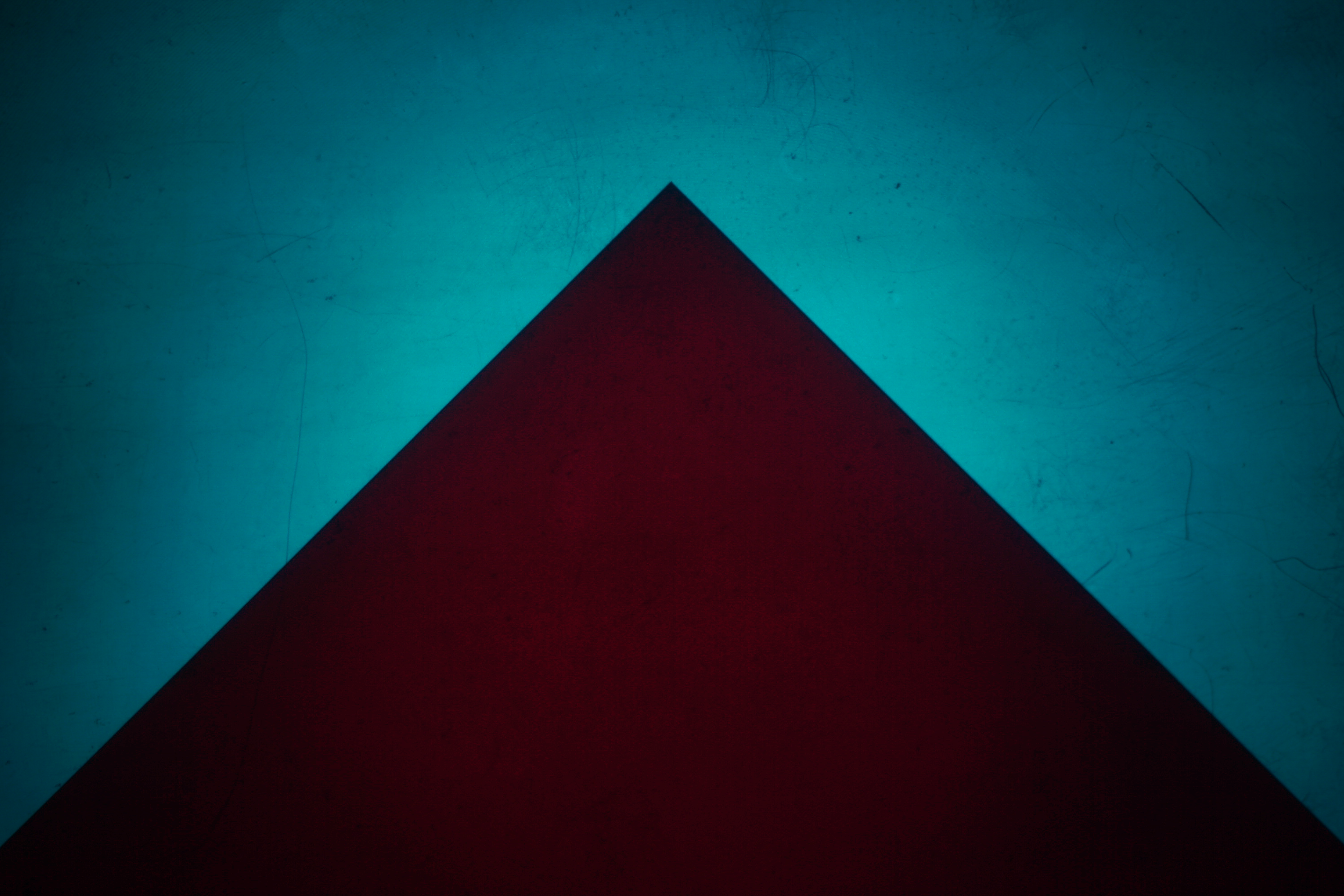
Colored cellophane on overhead projector
As I played with the cellophane and overhead projector on my last day at the residency, I was naturally reflecting on what I enjoy about making art and the act of creating. It’s the process of metamorphosis. It’s the idea of non-infallible physics: that boundaries are relative rather than strictly defined. Just because it’s in a textbook doesn’t mean it’s true and indeed a peer review is not infallible. It’s the practice of molding my own reality. It’s the thought of finding perceptive flaws in ourselves and how we define the world; moving beyond compartmentalization and the rigors of taxonomy. It’s the irregularities and abnormalities observed in dynamic equilibriums. It’s acknowledging the comfort we find in pursuing the scientific intricacies of the physical world but realizing there is more to what our instruments can measure; relinquishing control. Cycles rather than polarity. Exploring gradients and defining thresholds out of convenience not necessity. It’s the process of inspiring the mystery and wonder that have all but vanished from modern society. In a fast-paced digital world it’s the spark brought on by the awe of something mysterious that brings me joy. In short, it’s the process of making something unrecognizable from the original and influencing it’s evolution. Metamorphosis.
You’ll find many of the ideas I explored throughout the residency nested within my short film celestial beings.
Thank you for having me at Lakeside Lab!
I can’t wait to come back!









